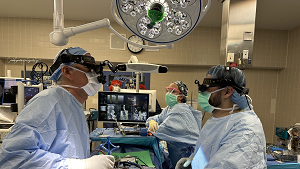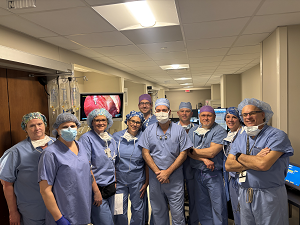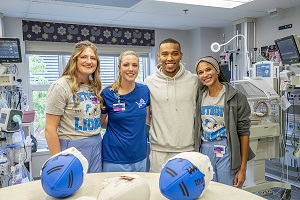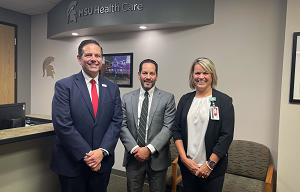Henry Ford Health completes first patient spinal surgery using augmented reality

DETROIT — Augmented reality, a cutting-edge technology used in everything from gaming and design to shopping and education, is now being used to increase accuracy during spinal surgery, leading to better patient outcomes and quicker recovery times. On Aug. 8, neurosurgeons at Henry Ford Hospital became the first in the U.S. to use the technology in a complex surgery involving a 66-year-old man from Clinton Township, who suffered from leg pain and cramping due to previously failed spinal surgeries at another hospital.
Augmented reality superimposes a computer-generated image on a user’s view of the real world, creating a composite view. The OnPoint Surgical System superimposes virtual surgical guides and virtual spinal implants, or screws, onto the surgeon’s visual field using see-through optical head-mounted displays.
Neurosurgeon Dr. Muwaffak M. Abdulhak, led the team that performed the milestone procedure using the OnPoint system. The technology brought navigation images onto the surgical field and into Abdulhak’s surgical loupes – magnifiers mounted within lenses on glasses – that allowed him to see a precise starting point for screw placement. This resulted in better accuracy, more precise placement of screws, minimum tissue disruption and shorter operating time.
 “There is a seamless transition between the patient and the augmented reality. I was able to see exactly where to place screws. The system also guided me on screw trajectory and depth,” Dr. Abdulhak said. “Using the new technology has made the surgery easier, safer and more successful because it is so accurate.”
“There is a seamless transition between the patient and the augmented reality. I was able to see exactly where to place screws. The system also guided me on screw trajectory and depth,” Dr. Abdulhak said. “Using the new technology has made the surgery easier, safer and more successful because it is so accurate.”
Augmented reality will gradually replace robotics during the procedure when a surgeon places and threads screw into the critical bone anatomy during spinal surgeries at Henry Ford.
“This new technology advances our patient care immensely,” said Dr. Ellen Air, Chair of Henry Ford Health’s Neurosurgery Department. “The augmented reality system empowers our surgeons when taking on the most complex cases and gives our patients a better chance of returning to high-quality, productive lives.”
Surgeons typically use CT-guidance — which uses a continuous X-ray beam to create a real-time video image of the internal structures of the body and allows surgeons to view the movement of body parts, instruments or devices through the body — to guide placement of implants or devices.
“I would have to look away from the operating field at a screen situated 5-10 feet away from the patient to guide the screws into place,” Dr. Abdulhak said. “The use of the new technology using augmented reality means there is less resection and less tissue disruption. The tissue is healthier and that translates to a faster recovery that is easier and less painful.”
The patient who underwent surgery on Aug. 8 was discharged from the hospital on day five after surgery, which is drastically faster than if he would have surgery using the old technology.
“His recovery is remarkable considering he’d previously had multiple failed surgeries in the past and could barely walk,” Abdulhak said. “Without the new technology it would have taken the patient longer to get out of bed, longer to walk and longer to be discharged.”
Henry Ford surgeons have successfully used the OnPoint system in nine cases to date.
There also are plans to use it for patients with spinal arthritis, spinal tumors and spinal trauma. Pediatric patients will also benefit as it significantly reduces exposure to radiation including intraoperative fluoroscopy and CT scan. With the OnPoint system young patients will be exposed to significantly less radiation.
“It's a tremendous privilege to be working in a hospital that empowers you to be on the cusp of new technology. I think we are writing a new chapter in patient safety during spine surgery,” Dr. Abdulhak said.
###
MEDIA CONTACT: mediarelations@hfhs.org
.svg?iar=0&hash=F6049510E33E4E6D8196C26CCC0A64A4)

/hfh-logo-main--white.svg?iar=0&hash=ED491CBFADFB7670FAE94559C98D7798)









